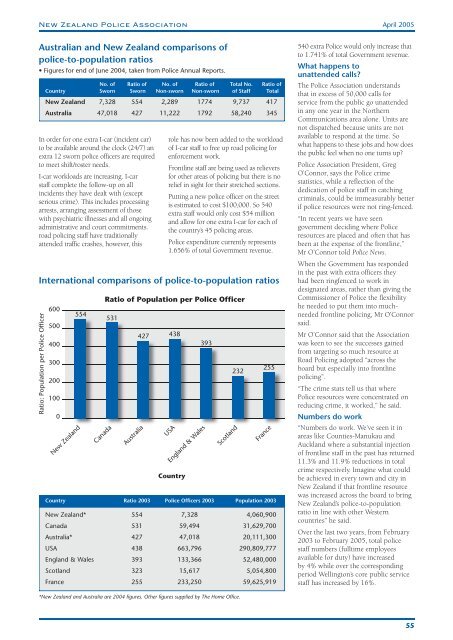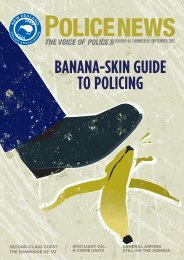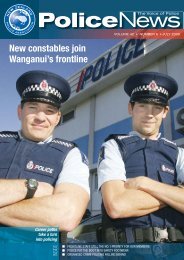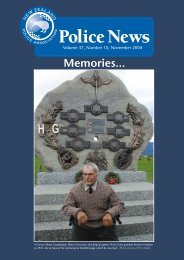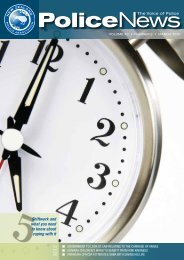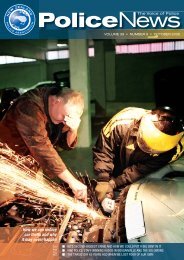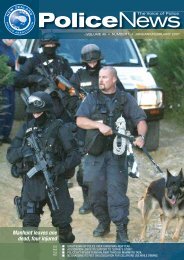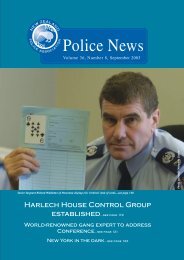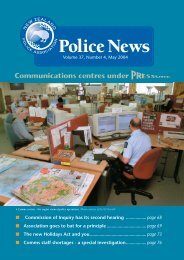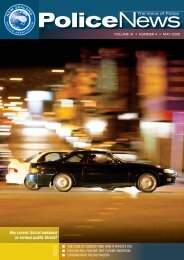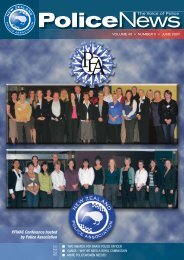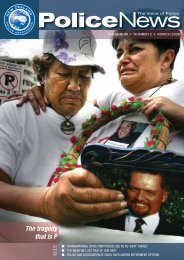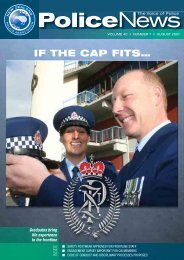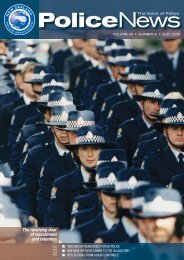<strong>April</strong> 2005<strong>Police</strong> <strong><strong>New</strong>s</strong> The Voice of <strong>Police</strong>“Fund the frontline” campaign for 540 extra policein the next two years and a total of 10,000 by 2010by Steve Plowman, Editor, <strong>Police</strong> <strong><strong>New</strong>s</strong>The <strong>New</strong> <strong>Zealand</strong> <strong>Police</strong> <strong>Association</strong> hasbegun a “Fund the frontline” campaignaimed at increasing frontline policenumbers, in the short-term, by 540 swornpolice officers.Longer term, the campaign has a “Ten byten” strategy, aimed at boosting currentsworn police numbers from 7,238 to10,000 by 2010.In the Government’s first and second terms,all but 50 of the extra police supplied havegone to specific (tagged) areas. These areasof tagged funding include, Highway Patrol,DNA teams, DNA analysis, law enforcementteams, youth aid analysis, national securityinvestigations and overseas positions.The remaining 50 ‘untagged’ police went towork in Auckland in general response andinvestigation areas.The public must have confidence in their<strong>Police</strong>. In order for the <strong>Police</strong> to give thepublic the level of service they deserve theemergency response area of policing musthave the staff to respond. Not only areComms Centres short staffed but also thereare added pressures for frontline policeofficers to attend public calls for service.While police staff numbers have increasedover the term of this current Government,the reality is that the vast majority ofthose staff are non-sworn/civilians. Swornpolice numbers have steadily fallenbehind overseas police forces in termsof the ratio of sworn police officers topopulation. <strong>New</strong> <strong>Zealand</strong>’s ratios are setto worsen as several overseas police forcesare currently in the process of boostingtheir police numbers. Such moves have adual effect of benefitting the economy andmaking cities safer by lowering crime.<strong>New</strong> <strong>Zealand</strong>’s police-to-populationratio is amongst the worst in the westernworld at one police officer to every 554people. We have 18 police officers per10,000 of population while Australia has24 per 10,000. Regardless of whethercomparisons are inclusive or exclusive ofadministrative staff (non-sworn/civilian),<strong>New</strong> <strong>Zealand</strong> <strong>Police</strong> are still significantlyunderstaffed.Australians better servedAn extra 2000 police officers wouldbring <strong>New</strong> <strong>Zealand</strong> <strong>Police</strong> numbers up toAustralian staffing standards today.Scotland is a good internationalbenchmark for comparison. Its policingmodel is similar (i.e. unarmed police,population size and terrain). Scotland’spopulation at 5,054,800 is 24.47%greater than <strong>New</strong> <strong>Zealand</strong>’s 4,060,900 butScotland has 113% more police officers(15,617 in Scotland compared to <strong>New</strong><strong>Zealand</strong>’s 7,328). Similarly, Queensland<strong>Police</strong>, who have 9,000 staff and arelooking to add another 150, serve apopulation of 3.9 million. Queenslandalso has 185 federal police who areresponsible for combating counterterrorism, trans-national/organised crime,drug trafficking and people smuggling.Attendance indicatorsOne indicator of the need for morepolice is reflected in attendance timesfor emergencies. In 2003/2004 <strong>Police</strong>attended only 71% of calls within thetarget 10 minutes for urban areas. Theperformance standard is 90%. Bycomparison, the Fire Service attended90% of calls within seven minutes and98% within 10 minutes. (See Priority 1(P1) Calls below).[*Priority 1 (P1) Calls - ImmediateResponse (O-10 min service level)A Priority 1 (P1) call is where thereis an actual threat to life or propertyhappening now; violence is beingused or threatened; a serious offence/incident is in progress and offendersare present or leaving the scene;and serious vehicle crashes (person/strapped/seriously injured). <strong>Police</strong>endeavour to be at the scene within10 minutes of the event dispatch.]Serious violent crime, methamphetamineoffences and national security-relatedcrime are all increasing. These crimesplace a huge burden on already stretched<strong>Police</strong> resources, as they require intenseinvestigation. Volume crime (likeburglary) requires much less concentrateddedication of resources in order to createa substantial decrease in volume. Thisconcentration on volume crime means<strong>Police</strong> have improved their crime statisticswhile expending less of their preciouslylimited resources.Public opinionA recent UMR survey of the public posedthe question: “As far as you are aware, arethere too many, about the right amountor not enough frontline police in <strong>New</strong><strong>Zealand</strong> today? Some 78% of respondentssaid there were “not enough”. (February2005 UMR national telephone survey of750 <strong>New</strong> <strong>Zealand</strong>ers aged 18 years andover. Margin of error ±3.6%.)Where are all the extra police?• There are record numbers of policestaff. Most of those extra positionsare non-sworn/civilians. <strong>New</strong><strong>Zealand</strong>’s population is at recordlevels too.• In this government’s first and secondterms all but 50 of the extra <strong>Police</strong>have gone to specific (tagged) areas- Highway Patrol, DNA teams, DNAanalysis, law enforcement teams,youth aid analysis, national securityinvestigations and overseas positions.• The untagged police went toAuckland to work in 50 generalresponse and investigation areas.Why do we need more police?• Communication Centres are shortstaffed - they also have the addedpressure of shortages of frontlineresponse police officers who are meantto attend public calls for service.• <strong>Police</strong> attendance times foremergencies (2003/2004) was 71%of calls within 10 minutes for urbanareas. The target is 90%. The FireService attended 90% of calls withinseven minutes and 98% within 10minutes.• Areas of policing, which are resourceintensive (such as cases of seriousviolent crime) are increasing. <strong>Police</strong>don’t have sufficient staff to dealwith this crime.• For the public to have confidence inthe <strong>Police</strong>, the emergency responsearea must be the best-resourced partof <strong>Police</strong>. Public need reassurancetheir police are readily accessible. Ina recent UMR Survey 78% said therewere “not enough” frontline policein <strong>New</strong> <strong>Zealand</strong> today.• Currently, funding is ring-fencedinto non-emergency areas and thefrontline is left as the most poorlyresourced.• <strong>New</strong> <strong>Zealand</strong> <strong>Police</strong> have one oflowest sworn police-to-populationratios in the English-speaking world,with one officer to every 554 <strong>New</strong><strong>Zealand</strong>ers. Australia has one policeofficer to every 427 citizens.• It’s absolutely essential that thenext Budget address shortages inthe emergency response area ofpolicing so that public confidencein police service is restored. <strong>Police</strong>expenditure currently represents1.656% of total governmentrevenue. An initial 540 extra <strong>Police</strong>(one I-car in each of the policingdistricts) would increase that toonly 1.741% of total governmentrevenue. Ten thousand by 2010would only require another 0.43%of total government revenue.54
<strong>New</strong> <strong>Zealand</strong> <strong>Police</strong> <strong>Association</strong><strong>April</strong> 2005Australian and <strong>New</strong> <strong>Zealand</strong> comparisons ofpolice-to-population ratios• Figures for end of June 2004, taken from <strong>Police</strong> Annual Reports.No. of Ratio of No. of Ratio of Total No. Ratio ofCountry Sworn Sworn Non-sworn Non-sworn of Staff Total<strong>New</strong> <strong>Zealand</strong> 7,328 554 2,289 1774 9,737 417Australia 47,018 427 11,222 1792 58,240 345In order for one extra I-car (incident car)to be available around the clock (24/7) anextra 12 sworn police officers are requiredto meet shift/roster needs.I-car workloads are increasing. I-carstaff complete the follow-up on allincidents they have dealt with (exceptserious crime). This includes processingarrests, arranging assessment of thosewith psychiatric illnesses and all ongoingadministrative and court commitments.road policing staff have traditionallyattended traffic crashes, however, thisrole has now been added to the workloadof I-car staff to free up road policing forenforcement work.Frontline staff are being used as relieversfor other areas of policing but there is norelief in sight for their stretched sections.Putting a new police officer on the streetis estimated to cost $100,000. So 540extra staff would only cost $54 millionand allow for one extra I-car for each ofthe country’s 45 policing areas.<strong>Police</strong> expenditure currently represents1.656% of total Government revenue.International comparisons of police-to-population ratiosCountry Ratio 2003 <strong>Police</strong> Officers 2003 Population 2003<strong>New</strong> <strong>Zealand</strong>* 554 7,328 4,060,900Canada 531 59,494 31,629,700Australia* 427 47,018 20,111,300USA 438 663,796 290,809,777England & Wales 393 133,366 52,480,000Scotland 323 15,617 5,054,800France 255 233,250 59,625,919540 extra <strong>Police</strong> would only increase thatto 1.741% of total Government revenue.What happens tounattended calls?The <strong>Police</strong> <strong>Association</strong> understandsthat in excess of 50,000 calls forservice from the public go unattendedin any one year in the NorthernCommunications area alone. Units arenot dispatched because units are notavailable to respond at the time. Sowhat happens to these jobs and how doesthe public feel when no one turns up?<strong>Police</strong> <strong>Association</strong> President, GregO’Connor, says the <strong>Police</strong> crimestatistics, while a reflection of thededication of police staff in catchingcriminals, could be immeasurably betterif police resources were not ring-fenced.“In recent years we have seengovernment deciding where <strong>Police</strong>resources are placed and often that hasbeen at the expense of the frontline,”Mr O’Connor told <strong>Police</strong> <strong><strong>New</strong>s</strong>.When the Government has respondedin the past with extra officers theyhad been ringfenced to work indesignated areas, rather than giving theCommissioner of <strong>Police</strong> the flexibilityhe needed to put them into muchneededfrontline policing, Mr O’Connorsaid.Mr O’Connor said that the <strong>Association</strong>was keen to see the successes gainedfrom targeting so much resource atRoad Policing adopted “across theboard but especially into frontlinepolicing”.“The crime stats tell us that where<strong>Police</strong> resources were concentrated onreducing crime, it worked,” he said.Numbers do work“Numbers do work. We’ve seen it inareas like Counties-Manukau andAuckland where a substantial injectionof frontline staff in the past has returned11.3% and 11.9% reductions in totalcrime respectively. Imagine what couldbe achieved in every town and city in<strong>New</strong> <strong>Zealand</strong> if that frontline resourcewas increased across the board to bring<strong>New</strong> <strong>Zealand</strong>’s police-to-populationratio in line with other Westerncountries” he said.Over the last two years, from February2003 to February 2005, total policestaff numbers (fulltime employeesavailable for duty) have increasedby 4% while over the correspondingperiod Wellington’s core public servicestaff has increased by 16%.*<strong>New</strong> <strong>Zealand</strong> and Australia are 2004 figures. Other figures supplied by The Home Office.55


